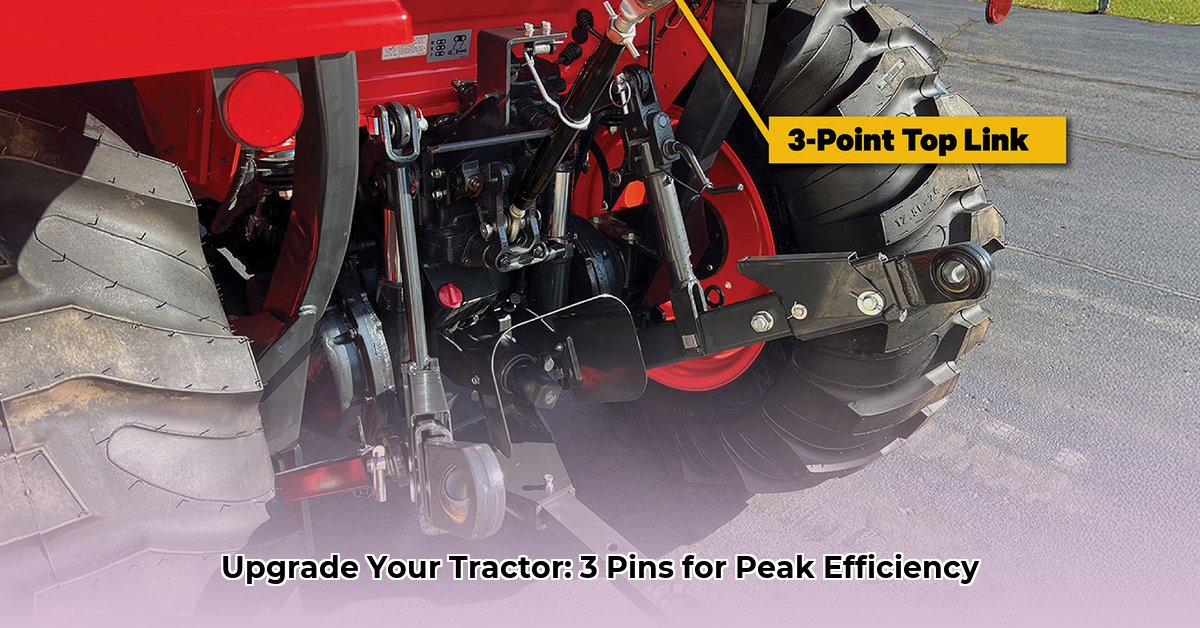
3-Point Tractor Pins: Your Key to Smooth Sailing on the Farm
Farm work demands reliable equipment, and often, the smallest parts play the biggest roles. 3-point hitch pins, seemingly insignificant, are the unsung heroes connecting your tractor to essential implements. A secure connection translates to less downtime, fewer headaches, and increased productivity. This guide covers pin selection, maintenance, and safety, maximizing your uptime and minimizing frustrating breakdowns. Don't let a small component derail your entire operation; read on to learn how to choose, install, and maintain 3-point tractor pins effectively. Did you know that using the incorrect pin can lead to a 30% increase in equipment failure? For more on 3-point spreaders, check out this helpful resource: 3-point spreaders.
Understanding 3-Point Hitch Pins: More Than Meets the Eye
3-point hitch pins are the crucial connectors between your tractor and implements like plows, balers, and spreaders. They're essential for seamless transitions between tasks. However, choosing the correct pin is critical for proper operation and safety. The type of pin you need depends on several factors, including material, size, and design.
Several pin materials exist, each with varying durability and cost. Standard steel is budget-friendly but may wear faster. Hardened steel offers exceptional durability for demanding tasks. Specialized alloys, while more expensive, provide superior strength and wear resistance.
Pin size and design also matter. Check your tractor and implement manuals for specific requirements; using the wrong size is dangerous and can lead to equipment damage or injury. Some pins have features to improve durability or prevent accidental removal.
Selecting the Perfect Pin: A Step-by-Step Guide
Choosing the right pin is crucial for preventing costly repairs and accidents. Follow these steps:
Consult Your Manuals: Your tractor and implement manuals specify the correct pin size and type. This is your most important resource.
Assess Implement Weight: Heavier implements require stronger pins to handle increased stress. Using a lightweight pin with heavy equipment is dangerous.
Consider Work Conditions: Will you be working in rocky soil or performing lighter tasks? This influences the required pin durability.
Choose a Reputable Supplier: Invest in quality pins from trusted suppliers. Cutting corners can lead to premature failure and safety risks.
Here's a comparison table of common pin materials:
| Material | Durability | Cost | Corrosion Resistance | Notes |
|---|---|---|---|---|
| Standard Steel | Moderate | Low | Low | Suitable for lighter implements and occasional use |
| Hardened Steel | High | Medium | Moderate | Offers better durability for regular work |
| Specialized Alloys | Very High | High | High | Best for heavy-duty applications |
Installation and Maintenance: Keep Those Pins Happy!
Proper installation and regular maintenance are vital for extending pin lifespan.
Installation: Insert the pin carefully, ensuring it's fully seated. If it feels difficult, double-check you have the correct pin. Avoid excessive force, which can cause damage.
Inspection: Regularly inspect pins for wear (bending, scratching, cracks). Pay close attention after working in challenging conditions. Replace any damaged pins immediately.
Lubrication: Periodically lubricating pins with grease reduces friction and extends their lifespan.
Troubleshooting and Safety: Handling Potential Problems
Even quality pins can fail. Addressing issues promptly and safely is essential.
Common Problems: Bent or sheared pins and worn pins are common issues.
Solutions: Replace damaged pins immediately. Never attempt to repair a bent or damaged pin; it's unsafe.
Safety First: Always disconnect power before working on the 3-point hitch. Wear appropriate safety gear (gloves and safety glasses).
Wrapping it Up: The Importance of the Unsung Heroes
Reliable 3-point tractor pins are essential for efficient and safe farming. Choosing the right pins, proper maintenance, and addressing problems promptly save time, money, and prevent accidents. Invest in quality for a smoothly functioning farm operation. Remember, proactive maintenance translates directly to increased profitability. What percentage of your downtime can you attribute to pin-related issues?
Resources
(This section would contain links to reputable suppliers and relevant agricultural organizations.)